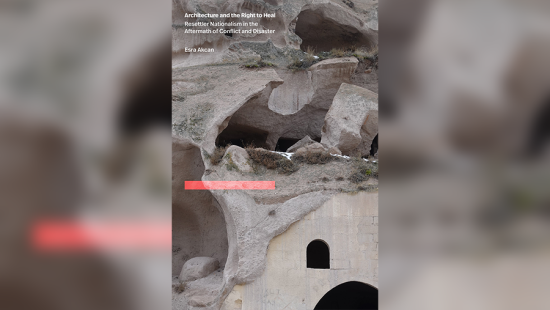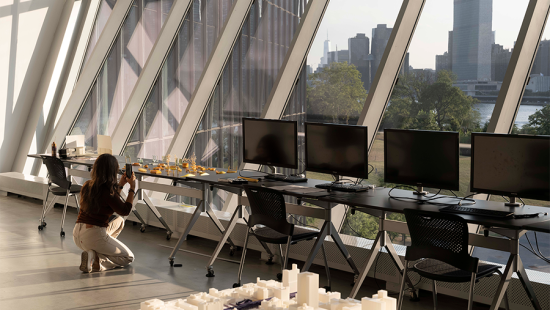Found in Translation: (Re)Connecting with Roman Archaeological Sites in the Heart of the City
After winning an international design competition, Francesco Isidori and Maria Claudia Clemente brought that brief to their Cornell in Rome architectural design studio this semester, offering their students the opportunity to engage with major Roman sites both ancient and contemporary.

Labics's winning competition visualization. image / courtesy Labics
Early this year, the City of Rome announced the winning design of an international competition aimed at the redevelopment of the Via dei Fori Imperiali and surrounding Imperial Forum archaeological sites. Labics, a design office cofounded by Francesco Isidori and Maria Claudia Clemente, was selected for their proposed promenade, which will improve access to and understanding of this iconic setting for both residents and tourists by connecting monuments spanning the Colosseum to the city center.
"The central archaeological area is one of the places in the city where the signs and traces of the most significant eras of Roman history clearly overlap, from the most ancient to the most recent times," Isidori and Clemente explain. "This place, therefore, appears as a large palimpsest in which different scripts coexist and overlap in different ways." To make the space more intelligible and physically accessible to a wide audience, their design plan includes walkways, bicycle paths, green spaces, and balconies, creating greater interaction and connection with the surroundings.
Considering that the setting represents the physical and symbolic core of the city, not to mention the level of knowledge and materials Isidori and Clemente have amassed on the area through their study and reflection for the competition, the topic presented an ideal area to explore with their architectural design studio students at Cornell in Rome this semester where they are both serving as Architecture Visiting Critics. They endeavored, however, to give the students additional freedom and took a more experimental attitude than the original design brief allowed. They challenged the students to reflect on the role of the central archaeological area in the city today, which has become a large tourist destination: How is it possible to return this part of the city to the local community and contribute to the quality of available public space?

Conceptual model and site analysis by Anabelle Lau (B.Arch. '26). image / provided

Conceptual study model by Raihaan Bose (B.Arch. '26). image / provided
To further investigate the relationship between architecture and public space, the students embarked on field trips covering Arezzo, Urbino, Ravenna, Venice, Florence, Naples, and Matera. Readings for the course included not only architectural and urban planning texts, but also Italo Calvino's poetic novel Invisible Cities. Architecture Assistant Professor Luben Dimcheff, who served as coordinator for the course, explains the connection between the text and the studio. "The book is a beautiful form of story-telling; the studio is about that too — recording, translating, and projecting a story," he says. "We are less interested in the obvious and the pragmatic; we encourage, well, the courage to imagine the unbelievable, the preposterous, the audacious, the fantastical; yet as the text does so eloquently in the craft of its written word, we hope students are able to manifest their ideas in finite and exquisite architectural form and profound space, conveyed by drawing."

Ben Pahucki (B.Arch. '26) presenting Velatum Monumentum. Ryan Wang (B.Arch. '26) / AAP
Raihaan Bose (B.Arch. '26) said he appreciated the deep knowledge and understanding Isidori and Clemente brought to the studio and the "depth in thinking about the architectural intent and meaning encouraged by the professors in relation to an extremely complex and layered site context. The semester has reframed how I understand architecture, how architecture can be so much more than just the physical object occupying space, becoming more of an intellectual exercise for an individual to understand their own interpretations and opinions of their surroundings. I already know that this semester is going to be integral to the development of my thesis."
Massing study model by Jonathan Wilmers (B.Arch. '26). image / provided

Design development sketches by Katie Wang (B.Arch. '26). image / provided

Conceptual model and site analysis by Lily Mager (B.Arch. '26). image / provided

Conceptual site sections (left) and conceptual model and site analysis (right) by Ben Adomaitis (B.Arch. '26). images / provided

Taxonomy of elements by Max Leston (B.Arch. '26). image / provided

Massing study model by Jonathan Wilmers (B.Arch. '26). image / provided
Dimcheff, who was himself once a B.Arch. student in Rome and has since taught as part of the program several times, reflects on the truly formative experience offered to students. "Learning from Rome is an immersive and a rather palpable experience," he says. "Knowledge is embodied in the context — immediate and abstract, also persevering and fleeting, monumental and often barely a trace; the context is altogether epic and an epic — a long poem infused with knowledge passed through time. Knowledge is literally set in stone, but it is also in the air. Cornell in Rome creates the space to draw from that knowledge, to draw from the city. In the studio, we ask students to slow down, allow themselves to be overwhelmed, reflect that knowledge, synthesize it with their own bias, and project new lessons we all learn from; lessons meant to be passed on."
"It has become, for students and faculty alike, a pivotal point to reflect, reassess, and project," Dimcheff notes. "It is an opportunistic and rare moment to think and create freely outside of context, yet, ironically, in a place that is nothing but context."
Learn more about Cornell in Rome
Based at the spectacular 17th-century Palazzo Santacroce, students at Cornell in Rome are provided ample studio space, a library, and a materials shop. Program staff and faculty with decades of experience and deep knowledge of the city and its environs ensure a rigorous learning experience as well as robust extracurricular programming including tours, field trips, lectures, and other activities.









